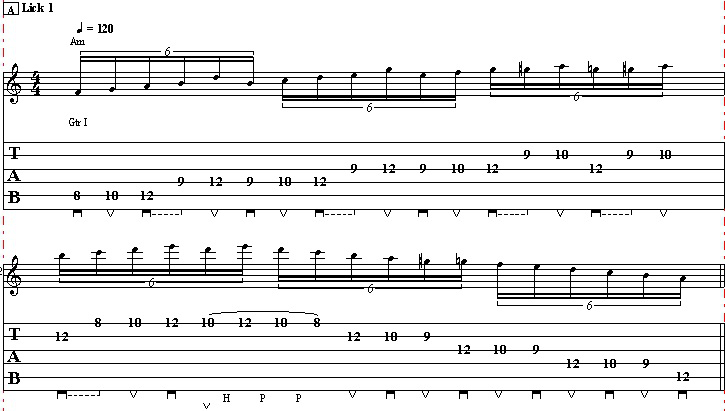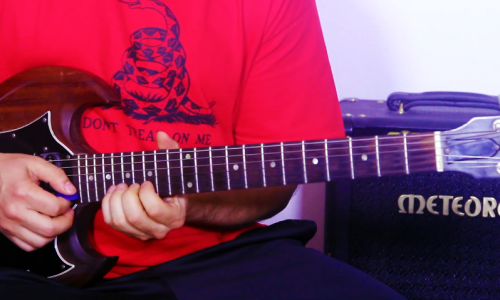Hey, how’s it going this is Shawn Daniel with Guitar Control, I’m going to show you how to “Jazzify” any chord in a Key.
[ninja-popup ID=715]
Click on the Tab button to follow the chords and tabs.
What does it mean to even Jazzify a chord? Basically in any key there are six main chords and then a 7th, which you sometimes use. We’re going to use the Key of G, as an example so let’s run through all the chords in the key of G we have G major, A minor, B minor, C major, D major, E minor, and we have that F sharp, which is like a diminished chord and then back to G. Those are all the notes in the G Major scale 1, 2, 3, 4, 5, 6, 7, but all those notes become a chord G major, A minor, B minor, C major, D major, E minor, F diminished, and then back.
First of all you don’t want to know that, it’s pretty important that’s why you can like number of chords and stuff like that. Now you can play any of those chords in any order and come up with a cool song or you can get a little jazzier. This isn’t just for playing jazz but you can add a note to every single one of those chords that we just did it to make it sound jazzier and then use that knowledge to whatever means that you’re up to
When I say we’re going to add a note from that key and it will be the seventh note away from where we start. I want to talk about how many notes during these chords like this G major chord we started with it’s called the triad because it only has three notes, it’s important to know the names of those notes like a G of B and a D even though we’re playing six strings like three different notes this is a G, this is a B, another G, another B, another G.
What I said earlier about adding another note to that chord to make a jazz easing turn to a major 7 chord. So seven notes away from G 1, 2, 3, 4, 5, 6, 7, in that major scale as being an F-sharp, so we’re going to add this note to this chord and thus we get this . This is going to be our first jazzy chord G major 7, now you already kind of hear a little bit of this, just take a regular chord progression like G, B minor to C, G, B minor, to C, G, now as you see G major 7, that’s fine.
It has a subtle difference that might not be jazzy, I mean that’s how you define that word but this is a great chords notes. We start with the same note, I’ll be with a different finger than a regular G major chord voice and your pointer finger is on the 3rd fret of the E-string. We’re going to skip the A-string, your ring finger will grab the 4th fret of the D-string, grab the 4th fret of the G-string and your middle finger will grab the 3rd fret of the B-string.
Here’s your note G and this hand shape gives you the major 7th chord, now you can move this round G major 7, G sharp major 7, A major 7, A sharp major 7 and so on and so 4th. But in this key, this is our new 1 chord you can always replace a G with. So the next chord, what’s the 2nd chord in the key of G? G, A minor, now you do the same thing, we’re going to take the 7th note away from A in the G major scale and then add that to this chord okay so if trying to A 1, 2, 3, 4, 5, 6, 7, we actually get a, g, a, b, c, d, e, f, g, so if we add a G to A minor we get an A minor 7.
Now the easiest way to do this cord, right here A minor put your pinky down on the 3rd fret of the high E-string so you have G, G major 7, to a minor 7. I’m thinking about this shape right here, try moving it let’s try it. Remember how we moved to this doesn’t get the same effect so we’re going to learn a closed voice shape. It’s going to look like this, now this version of the A minor 7 is really easy conceptually, you just barred the 5th fret but skip the A-string. So I have 5E with my middle finger, 5D with my ring finger, 5G with my pinky, you can play it just like that.
There’s a couple different ways that we can do this, I just want to make it easier way we have three notes like this, but still counts as an A minor 7, G major 7, to A minor 7, the great thing about this shape like I said, we’ve been moving around so that’s we’re going to do for the 3rd note in the Key of G that B, G, A, B, B minor is usually the cord that we’ve done, we’re going to swap this off for B minor 7 we’re we just take this shape and move it two frets higher G major 7, A minor 7, B minor 7, and then we get to a C.
C is the 4th chord in the key of G, now we can make this A major 7 by taking the 7th note away from C and that key C, D, E, F sharp, G, A, B, so we just need to find a way to add a B note to a C. Easy way to do is pop your pointer finger off there make it and we’re going to take the same shape as the first one but now we route it on the eighth fret of the low E-string, so instead of G minor, B minor, C, we have G major 7, A minor 7, B minor 7, C major 7.
What’s the 5th note in the key of G? It’s usually a D major chord, you might think that you could just add that same thing as before to make it a D major 7 chord that’s tactically going outside of the heel but the interesting thing about the 5th note in any key is it turns into a dominant seven chord voicing so D dominant 7, a D7 might be something you’ve seen before again the difference between a major 7 and a dominant 7 or D7, is just that 7th note away from a key.
Dominant seven has it’s called a flat 7, again if that’s something interesting we have a lot of videos on music theory on this channel that I’ve done before, so check those out. This is a D7 shape that you’ve learned before great finger to you pointer finger 1B, middle finger to G, and then open D. I want to take the same shape but do it in a closed voice down here on the 10th fret. This is going to be a jazzy D7, so middle finger on that D, 10th fret of the low E-string, pointer finger 9, ring finger 10, D pinky, 11 G.
So G major 7, A minor 7, B minor 7, C major 7, g7, now notice I’m distinguishing between that root and the rest of the board cool sound. We’re accentuating the Jazziness of that chord, now the 6th chord in the key of G, G, A, B, C, D, E minor, E, is another minor chord therefore we can turn it into another minor 7 chord.
Let’s keep doing that I’m in the 12th fret same shape with the A and the B, now is the E minor seven chords voicing. Much easier way to make a minor seven chord voicing, let’s make an E minor chord and just lift the ring figure out. Open E minor 7, close you minor 7 technically the same chord. Those are the six main chords the last one we’re at is the 7th chord which is going to be a minor seven flat five or a half diminished chord as what it’s called.
So in the key of G that’s seventh note is F sharp, we’re going to figure out a way to add a chord voicing that gives us that next chord. One way to do it would be this chord voicing, here that’s kind of a tricky one depending on the guitar you choose especially under acoustic guitar. F sharp minor seven flat five rooted on the E-string is a tough one you do it up here and I think the chord voicing that we’re going to use are the one that we use for this video. The 9th fret of the A string is our root, the 10th fret on the D-string with your ring finger the 9th fret of the G with your middle finger and a 10th fret of the B string with your pinky. The great thing about this is we’re going to end here which is a higher voice G major 7th chords that’s a free chord voicing, a bonus chord voicing. There’s a seven chord F sharp half diminished, now if we move this two frets higher and take your pointer finger back that gives us the A-string rooted version of a major 7 chord.
This is a G the tap from a string is a G, G major 7, now we can run through what’s called a chord scale of these in Jazzy terms the chord scale is just like a scale when instead of single notes you get the corresponding chord so instead of G, A, B, C, D.
I’ll go through that one more time Solo and the end make sure you click the link below because it has the tab of all these in a row G major 7, A minor 7, B minor 7, C major 7, D7, 7 E minor, 7 F sharp half-diminished. You can mix those up in any order and it’ll sound kind of jazzy, you just randomly go through and usually it’ll sound resolved when you end up at home here, so just kind of a quick almost like an intro to jazz chords lesson you know is a lot more to jazz but I think that’s a great place to start so if you have any questions let us know and make sure to click any of these other videos around by myself and other great instructors of the Guitar Control.
Make sure to subscribe on our YouTube Channel and we’ll see you in our next video lessons, thanks for watching.




